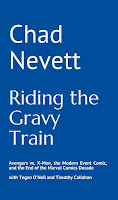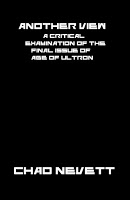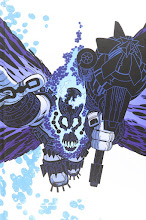And here we have my weekly look at what I bought during the previous week...
The Death of the New Gods #6Shit, I much rather prefer my idea where Mister Miracle becomes corrupted by the Anti-Life Equation to the point where he turns out to be the killer and Orion uses the Source in a similar manner, the two working against one another as pawns of the greater forces. Instead, it's the lame guy with a paunch. Lame.
Aside from that revelation, I really enjoyed this issue. Starlin's depiction of Orion here is fantastic, demonstrating why the character is more than just a brutish thug. I'm also liking his Mister Miracle, a man so despondent that he's at the edge of his sanity. It plays right into Starlin's usual interests.
I will admit that his art on this book is a lot weaker than that he did at Marvel. I don't know why, but he just can't seem to find a groove with these characters. He does a decent Darkseid and Metron, but everyone else is pretty weak.
I look forward to the last two issues of this series as well as
Holy War. Come on, Starlin and Lim together again--if you're not excited about that, you just hate comics. (Kidding.)
Mighty Avengers #9This is a mostly boring issue with the Avengers versus Doombots. Whoo. There's a fight between Iron Man and Dr. Doom where Doom pulls out
*gasp* magic! Because that's such a fucking surprise considering he's widely known as second only to Dr. Strange or something. I thought Tony Stark was supposed to be smart. But, then again, he's a Futurist, which means a total obsession with machines, violence and death, while shunning outdated things like magic, loyalty and logic.
The issue ends with Iron Man and Doom back in the past where pointillism colouring signify that it's the past... except
Rocky is playing at a theate, which means we're talking 1976... and they're using pointillism to suggest that era? Was the colouring really that bad back then? I don't think I actually own a comic from that period (or, not an original comic at least), so I can't check, but it feels wrong to me. It makes me wonder when we'll see flashbacks to the 1980s that uses the same thing and then the '90s and then 2008... how long until stories taking place in 2008 are signified with pointillism?
I did enjoy the three double-page spreads to show the giant fight. They work better individual panels since the fight is a giant melee and large spreads depict that much better.
My favourite part of this issue? When Tony looks out on 1976 New York, we see a billboard for Camel Cigarettes. Must have slipped past ol' Joey Q, eh? (Is it weird that I feel the need to champion any runaround Quesada's 'no smoking' edict? I don't smoke and generally think that anyone who does is kind of stupid. But, then again, the edict bothers me for some reason. I guess it's the same--to me--as putting out an edict that says there will no longer be stupid people in Marvel comics.)
Something occurred to me a week or two back: has Tony's alcoholism been addressed much since/during
Civil War? I haven't seen it mentioned in the books I've been reading, so it MUST have been mentioned in his title. And, if not... why? If you being partially responsible for Captain America getting killed after fighting against a lot of friends followed up with the responsibility of proving you weren't completely wrong and running the largest military force in the world doesn't make you want a drink, then what would? Can anyone help me out here?
Ultimate Human #2Speaking of an alcoholic Tony Stark... does Ultimate Tony ever NOT have a drink in his hand? This guy fucking lives on vodka it seems. It's like if you took all of the water, juice, milk, coffee, and pop the average person drinks in a day, multipled it by ten and replaced it with vodka, you'd get near how much of the stuff this guy drinks. Do the nanites in his body run on the stuff? Do his Ultimate Iron Man suits? Has Ultimate Tony Stark invented machines that
require him to drink vodka all day constantly? Ultimate Tony Stark is my new favourite hero.
...wait, I see panels where Ultimate Tony is drinking coffee. At least, Ultimate Bruce is and Ultimate Tony has a mug with steam coming out... unless he's invented a coffee/vodka blend where it's just hot brown vodka that he passes off as coffee, because he realises everyone is concerned about his drinking, but fuck them because Ultimate Tony Stark runs on vodka and loose women... okay, I'm going to stop right there or else I may just wind up writing a long paragraph about the lengths Ultimate Tony will go to make sure every liquid he takes in is actually vodka... think about it... think about it... there you go... yes, I'm a sick, sick man... I'm sorry. (And if for whatever reason you don't realise what I'm getting at, you're better off. Trust me.)
This issue is decent, but the first one was better. Still, probably just for the ending, but this one is good. It sets up the next two well while resolving elements of the first. Ultimate Bruce is cured of being the Ultimate Hulk, but I imagine that's a bad thing now that Ultimate Pete Wisdom (the Ultimate Leader) has kidnapped them. I don't actually care about the plot that much, I just want to see Ultimate Tony find new and interesting ways to get vodka while locked up by Ultimate Wisdom--who will rant to them about his giant head--his giant Ultimate head--and how he should be them, he should be an Ultimate, rather than some crazy freak who wants Ultimate Bruce Banner's blood so he can become Ultimate Hulk and explore Ultimate space as an Ultimate Super-Soldier.
...do you think Ultimate Tony drinks a vodka called Ultimate Absolut? Or how about Ultimat?
...god i need a drink...
Youngblood #2Casey has given Shaft the shaft. SPOILER!
...shit, the "SPOILER!" goes ahead of the soiled part of the story... there it just seems like I'm weird energetic person who does something and then yells what I just did. Like I show up at the store after walking there and yell "WALKED!" That would be pretty weird...
A much stronger issue than last month's debut, Casey pushes the concept to an area that I love: fictional. Youngblood has a fake rivalry straight out of Vince McMahon's playbook. I've long wanted more comics to emulate wrestling since I see many obvious connections. Actually, my idea was for a
Mighty Avengers or
Avengers: The Initiative annual where the registered heroes put on a charity event where they all fight each other in wrestling-like matches. The outcomes are predetermined as are some of the moves used--a cool way to showcase the government heroes and do it for a worthy cause...
While we're on the subject, why does the fact that wrestling's events are scripted take away from it in the eyes of some? It's just like any other fictional show, except they still have to
do the fucking moves. What, because they know Triple H is going to beat Umaga, that suddenly makes getting slammed onto a chair painless or doing a suplex effortless? Like the illusion that it was a sport was what mattered--it's athletic fiction.
Anyway... this is a cynical comic that has everyone involved totally aware that it's a fiction, except not the larger fiction. Casey has pushed the concept further and managed to kill off the one character who probably wouldn't have gone along with it.
What does Johnny Panic do as a postmodern superhero?
Badrock is breaking up... heh.
This marks the second (that I can remember) appearance of Bill Maher in a Joe Casey comic--the first waaaaaaaaaaaaaay back in
X-Men: Children of the Atom (which I will get to at some point in my look at his work here on GraphiContent), except then, it was
Politically Incorrect and now it's
Real Time. I do love me some Bill Maher--I wonder if he's aware of his appearance in this comic...
The art on the book isn't wowwing me. It's a little simplistic and cartoony in an unappropriate manner. I know that since we're dealing with varying levels of fictionality that an obviously unreal art style may be appealing, but I think a more realistic or, possibly, surreal style would suit the subject matter more. Particularly since the levels of fictionality are not handled in a childish manner, but a more nuanced, adult one that examines the cynicism of the modern world. Or something.
I do wish Casey was a little more subtle in his explorations of metafiction here, though. His one failing is that he has a tendency to not only do something cool, but to feel the need to tell you he's doing something cool as he's doing. It's not quite as pronounced as Mark Millar's need to the do the same, but it's there nonetheless. He needs to trust his audience more--although with the failure of more subtle, nuanced books that required actual thought and interaction from the audience like
Wildcats Version 3.0,
Automatic Kafka,
Mr. Majestic,
The Intimates, and
Deathlok, I can't say I blame him for going the obvious route.
Am looking forward to issue three...
Spider-Man: ReignTen dollar Marvel hardcovers, people. That's what the shop I go to here in Windsor has as Marvel attempts to get rid of some stock and provide an easy way for shops to full backstock as they realise maybe people don't always want hardcovers for books that they can still find singles for or wait two months for the trade. So, I picked up this book for ten bucks, which I'm really glad about since I wanted to check it out ever since the original issues came out (I couldn't find the first two, so I decided to wait for a collection).
I'm actually not quite sure what to make of this book, because the Peter Parker/Spider-Man we get here isn't the same as any version I've seen before. The difference between the two facets of his personality verge on multiple personalities, probably one of the reasons why this feels like
The Dark Knight Returns--aside from the similarity in approach and some artistic similarities. That disparity put me off initially because it is so different, so out of the form for a Spider-Man story. Parker may have had his problems, but to go this far?
Same with the Mary Jane delusions...
But, I think it works. Parker has always been pushed far and, after Mary Jane's death, the idea that he would go off the deep end a little makes sense. He isn't completely insane--just a tad insane.
There were a few elements of the story that weirded people out, particularly the radioactive spider-sperm that apparently killed Mary Jane. Seems like a logical extension of the character's powers to me and, well, a weird as fuck way to kill off MJ. What I noticed while reading this book was how it reflects on One More Day since the relationship between Mary Jane and Peter is held to such a high standard here--it's elevated so much that it makes discarding it seem even worse. Of course, the two stories are unrelated, but can't help but see it that way.
There are many similarities to
The Dark Knight Returns, including the style Kaare Andrews uses for the art--there are some panels that look really close to Frank Miller's work from that era. However, I find it interesting that this book's subject matter is a lot closer to that of
The Dark Knight Strikes Again as far as the antagonists go. Both of those books examine a post-9/11 world dealing with corrupt power figures that use security and terror to rule with iron fists, unafraid to use old villains to get their way, fighting against costumed heroes. In that way, I have a hard time taking
Reign too seriously--but I would say that it falls somewhere between the two Miller works. It's not as serious as
DKR, but it's not as absurdly comedic as
DKSA. (I could also see a little
Channel Zero in the book during the broadcast part of the story.)
The use of Venom is interesting as Andrews gives the character some really solid motivation for his attacks on Parker, painting Parker as the true villain and the symbiote as an innocent bystander. It works well and gives the final part of the book a bittersweet "victory."
Actually, a lot of
Reign is devoted to demonstrating that Peter Parker is a bit of a selfish asshole. The symbiote is brought to Earth and abandoned by him; he spends years lying to J. Jonah Jameson and using him to make a living; he never considers how his changed physiology could hurt Mary Jane... the Peter Parker of this book is haunted by the fact that he focused so much on one particular aspect of his "responsibility" that it led to him ignoring others. For the first time in a long time, I see the character as incredibly flawed--still heroic, but very, very flawed. Andrews has managed to make Peter Parker a complex and interesting character after decades of him being the same guy we've always known with no growth (except tiny little hints of change that never last).
I'm still not convinced, though, about the disparity between Parker and Spider-Man. That doesn't work for me... it's like Andrews pushed things too far in that regard, I'm not sure. That said, Spider-Man punching out Jameson at the end of issue one is one of those Great Moments... and really demonstrates the maturity and complexity of this Peter Parker.
If you haven't picked up
Reign, you should. I could probably go on a lot more about it, examining each character and what it means to Spider-Man. I mean, my god, the cemetary shit in issue three... what is that all about really? Wow. I may reread this book today, actually, and come back to it later here. Maybe during the summer.






